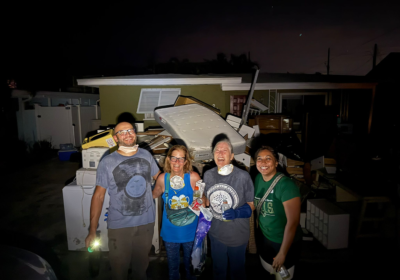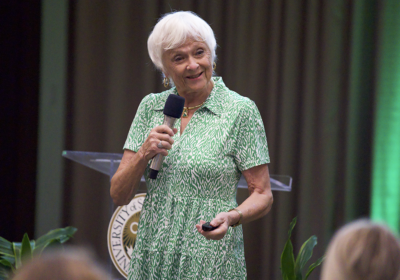Turning green into gold

As part of developing his solar panel proposal, John Pilz, a USF senior majoring in environmental science and policy, went to the MSC roof to look at the panels already in place there. SPECIAL TO THE ORACLE
After two years of work, project manager John Pilz received approval from the Student Green Energy Fund (SGEF) to work with a team to install 1,176 solar panels on the roof of the MSC — the maximum number it can support. While the MSC already produces some solar energy, this project will increase the amount to cut down on the building’s carbon footprint.
“The Marshall Student Center is an innovative building, home to many of USF Tampa’s signature events,” the proposal said. “It is recognized as a building that represents USF’s commitment to progress. USF Tampa’s most remarkable building, the MSC, can continue to lead in the alternative energy trend it has started to an even larger capacity, being the new definition of ‘turning green into gold.’
“Solar panels on the roof to generate power for the MSC is putting action to where USF’s mouth is.”
The panels are expected to last for 25 years and produce 634,995 kilowatts per year. According to the proposal submitted to the SGEF committee, the project is expected to produce more green energy for the school than any other project the fund has supported.
“The solar proposal was a project designed — since I started on it two years ago — to really make a difference with the (SGEF). To do, what I believe, the (SGEF) was created for,” Pilz, a senior majoring in environmental science and policy, said. “Which is to create green energy for USF and to make an impact with dollars that we have that one or two people can’t just do alone.”
The SGEF was developed for funding after USF system President Judy Genshaft signed The American College and University Presidents’ Climate Commitment in 2008.
This requires USF-Tampa to keep an eye on greenhouse gas emissions and come up with a long-term Climate Action Plan to eventually eliminate greenhouse gas emissions on campus.
“We (the MSC) pride ourselves on being part of the campus culture and reflect what’s the best things,” Sujit Chemburkar, MSC Director, said. “I know the Presidents’ Climate Commitment signed by President Genshaft is important so anything I can do in the (MSC) to help us get that carbon neutrality is important … and to be able to house a project of this nature and be the main focal point is a big honor for us.”
The fee is paid by all students based on the number of credit hours they’re taking, and projects are approved by a council of 15 members, 7 of whom are students.
During his time at USF, Pilz has been approved for five projects through SGEF; electric vehicle charging stations and LED lighting in the Beard parking garage, solar panels at the Solar Carport and most recently a tree planting day scheduled for next fall.
“I did apply, when I first came to USF, to do solar panels over parking lots but every single time I applied I got a response back ‘sorry your proposal misses this point or that point’,” Pilz said. “It kept focusing on things my proposal lacked rather than the proposal itself and the potential it had. I recognized that if I kept going the way I am, I’m going to fail every single time or I’m going to give up like everyone else did.”
The cost and regulations of installing solar panels over parking lots proved to be too high so Pilz turned to the roofs of buildings as a solution. This also proved difficult due to roofing warranties but with some research Pilz discovered that it shouldn’t be an issue as long as they follow the guidelines for what the roof manufacturers allow.
“I kept gaining contact with different people who told me different things,” Pilz said. “As I hit obstacles, I recognized that I have to change my original idea to get over these obstacles.”
On top of the solar panels for the MSC roof, the project also includes a monitoring system set up on the first floor of the building for students to follow how much energy the panels are producing and help to determine if a panel needs repairs. Such a system is already set up on the first floor of the MSC, but the project intends to revamp it.
“There is a monitor on the first floor of the MSC dedicated to showing the energy created by the already installed solar panels,” the proposal stated.
The document continues on to state that “Since that monitor (which has been in disrepair for several years) has been forgotten,” the goal is to repurpose the monitor and include it in the new plan.
The project received $1,437,822.22 to set up the panels, monitoring system and system maintenance, and pay solar energy fees with a little extra for “unforeseen contingencies.” Over the next 25 years, the panels are expected to save $1,270,071 for the school — a yearly saving of $50,803.
Chemburkar and his team at the MSC plan to work with Pilz and the contractor throughout the project. Also, once the panels are installed, they become part of the MSC and are therefore overseen by Chemburkar’s team. The official installation is expected to begin in the next four months.
“It’s going to be an amazing addition to the building as well as to the campus,” Chemburkar said. “We’re really proud to be part of this project, it’s been a long time coming. I think it shows our commitment as a university to being a green campus and it lowers our reliance on carbon-producing fuels.”






